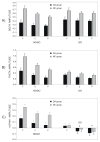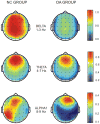Event-related oscillations in offspring of alcoholics: neurocognitive disinhibition as a risk for alcoholism
- PMID: 16213472
- PMCID: PMC3766847
- DOI: 10.1016/j.biopsych.2005.08.017
Event-related oscillations in offspring of alcoholics: neurocognitive disinhibition as a risk for alcoholism
Abstract
Background: Event-related oscillations (EROs) are increasingly being used to assess neurocognitive functioning in normal and clinical populations. The current study compares different frequency activities in offspring of alcoholics (OA) and in normal control subjects (NC) to examine whether the OA group exhibits any abnormality in oscillatory activity while performing a Go/NoGo task.
Methods: The S-transform algorithm was employed to decompose the electroencephalographic (EEG) signals into different time-frequency bands, and the oscillatory responses in the P300 time window (300-700 milliseconds) were statistically analyzed in both groups.
Results: The OA group manifested significantly decreased activity in delta (1-3 Hz), theta (4-7 Hz), and alpha1 (8-9 Hz) bands during the NoGo condition, as well as reduced delta and theta activity during the Go condition. This reduction was more prominent in the NoGo than in the Go condition.
Conclusions: The decreased response in delta, theta, and alpha1 oscillations, especially during the NoGo condition in high-risk individuals, is perhaps suggestive of cognitive and neural disinhibition and may serve as an endophenotypic marker in the development of alcoholism and/or other disinhibitory disorders.
Figures




Similar articles
-
Delta and theta oscillations as risk markers in adolescent offspring of alcoholics.Int J Psychophysiol. 2007 Jan;63(1):3-15. doi: 10.1016/j.ijpsycho.2006.10.003. Epub 2006 Nov 28. Int J Psychophysiol. 2007. PMID: 17129626 Free PMC article.
-
Delta, theta, and alpha event-related oscillations in alcoholics during Go/NoGo task: Neurocognitive deficits in execution, inhibition, and attention processing.Prog Neuropsychopharmacol Biol Psychiatry. 2016 Feb 4;65:158-71. doi: 10.1016/j.pnpbp.2015.10.002. Epub 2015 Oct 9. Prog Neuropsychopharmacol Biol Psychiatry. 2016. PMID: 26456730 Free PMC article.
-
Spatial-anatomical mapping of NoGo-P3 in the offspring of alcoholics: evidence of cognitive and neural disinhibition as a risk for alcoholism.Clin Neurophysiol. 2005 May;116(5):1049-61. doi: 10.1016/j.clinph.2004.12.015. Clin Neurophysiol. 2005. PMID: 15826845 Free PMC article.
-
Are cognitive processes manifested in event-related gamma, alpha, theta and delta oscillations in the EEG?Neurosci Lett. 1999 Jan 15;259(3):165-8. doi: 10.1016/s0304-3940(98)00934-3. Neurosci Lett. 1999. PMID: 10025584 Review.
-
P300-response: possible psychophysiological correlates in delta and theta frequency channels. A review.Int J Psychophysiol. 1992 Sep;13(2):161-79. doi: 10.1016/0167-8760(92)90055-g. Int J Psychophysiol. 1992. PMID: 1399755 Review.
Cited by
-
The Collaborative Study on the Genetics of Alcoholism: Overview.Genes Brain Behav. 2023 Oct;22(5):e12864. doi: 10.1111/gbb.12864. Epub 2023 Sep 22. Genes Brain Behav. 2023. PMID: 37736010 Free PMC article. Review.
-
Uncovering genes for cognitive (dys)function and predisposition for alcoholism spectrum disorders: a review of human brain oscillations as effective endophenotypes.Brain Res. 2008 Oct 15;1235:153-71. doi: 10.1016/j.brainres.2008.06.053. Epub 2008 Jun 24. Brain Res. 2008. PMID: 18634760 Free PMC article. Review.
-
Event-related oscillations in mice: effects of stimulus characteristics.J Neurosci Methods. 2009 Jun 30;181(1):52-7. doi: 10.1016/j.jneumeth.2009.04.015. Epub 2009 May 3. J Neurosci Methods. 2009. PMID: 19406149 Free PMC article.
-
Brain electrophysiological endophenotypes for externalizing psychopathology: a multivariate approach.Behav Genet. 2010 Mar;40(2):186-200. doi: 10.1007/s10519-010-9343-3. Epub 2010 Feb 13. Behav Genet. 2010. PMID: 20155392 Free PMC article.
-
Neural signatures of different behavioral types in fairness norm compliance.Sci Rep. 2018 Jul 12;8(1):10513. doi: 10.1038/s41598-018-28853-5. Sci Rep. 2018. PMID: 30002413 Free PMC article.
References
-
- Almasy L, Porjesz B, Blangero J, et al. Heritability of event-related brain potentials in families with a history of alcoholism. Am J Med Genet. 1999;88:383–390. - PubMed
-
- Basar-Eroglu C, Basar E, Demiralp T, Schurmann M. P300-response: possible psychophysiological correlates in delta and theta frequency channels. A review. Int J Psychophysiol. 1992;13:161–179. - PubMed
-
- Basar-Eroglu C, Basar E, Schmielau F. P300 in freely moving cats with intracranial electrodes. Int J Neurosci. 1991;60:215–226. - PubMed
-
- Basar-Eroglu C, Demiralp T, Schurmann M, Basar E. Topological distribution of oddball ‘P300’ responses. Int J Psychophysiol. 2001;39:213–220. - PubMed
-
- Basar-Eroglu C, Struber D, Kruse P, Basar E, Stadler M. Frontal gamma-band enhancement during multistable visual perception. Int J Psychophysiol. 1996a;24:113–125. - PubMed
Publication types
MeSH terms
Grants and funding
LinkOut - more resources
Full Text Sources
Other Literature Sources
Medical
Miscellaneous

